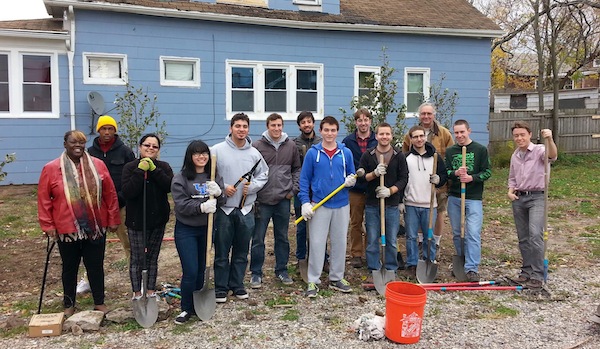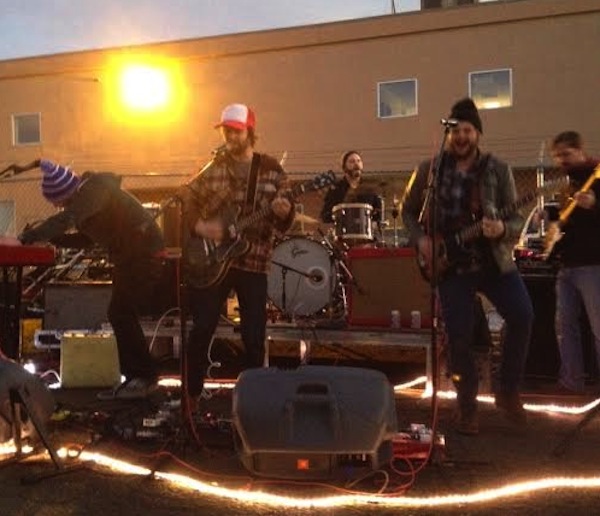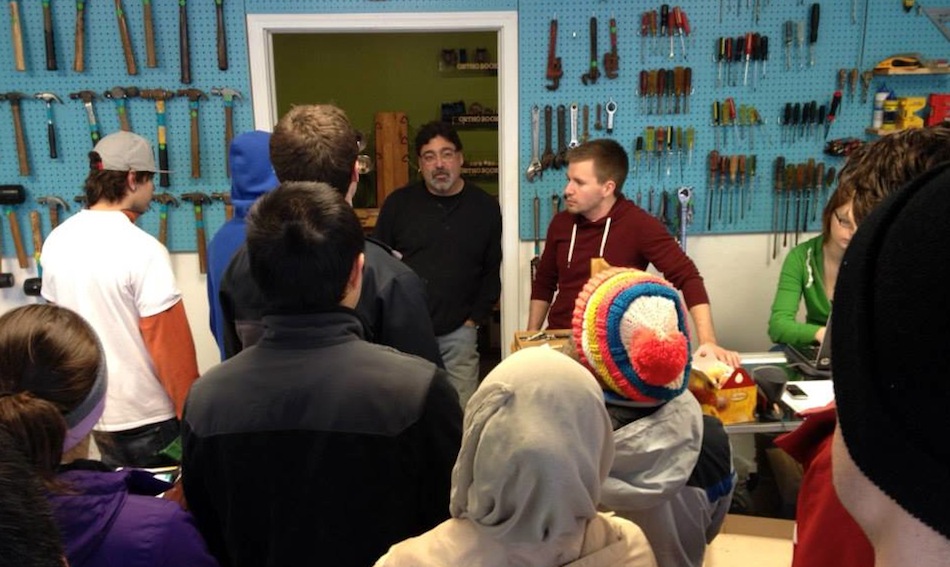Tool libraries are much-loved community resources, and for good reason: they expand access to tools, save members money, and strengthen relationships between neighbors.
However, they aren't easy to start, but that's changing. New fundraising, social media, and inventory management tools are making it easier to start, promote, and manage them. Crowdfunding is emerging as a powerful way to start or expand a tool library.
In addition to raising money, crowdfunding can help spread the word about a new tool library. As Gene Homicki, co-founder of myTurn explains, "people who may not have the time or tools to donate, but do have the financial resources to invest in their community, can become invested in the lending library's success."
This community support is vital to the success of a tool library. Of the 70-plus tool libraries that myTurn works with, the most successful are those that have engaged the community. “The people in the community want the tool library to succeed,” says Homicki, “both because it offers a valuable service…and also because they were part of co-creating an amazing community resource.”
Shareable connected with Sarah Steiner of the new Denver Tool Library, Aaron Krolikowski and Darren Cotton of the University Heights Tool Library in Buffalo, New York, and Alexandre Couture-Lalande, board chair of La Remise (the Shed), in Montreal, to find out how they ran successful tool library crowdfunding campaigns.
1. Have a Business Plan
A business plan forces you to crunch numbers, focus your vision, clearly lay out details, and decide how you’ll legally structure your tool library. For help, reach out to established tool libraries and see Shareable’s guide, How to Start a Tool Library In Your Community.
2. Get a Bank Account and Insurance
Before the crowdfunding campaign, set up a bank account and get insurance for the tool library. You’ll need an account for your funds to go into and it’s best to have insurance in place before the first tool is loaned.

Part of crowdfunding is coming up with fun incentives for donors
3. Research Crowdfunding Best Practices
Running a successful crowdfunding campaign is no small task. If you don't have experience running one, you may want to enlist the help of someone who has. This may mean finding a volunteer or hiring a crowdfunding pro. With crowdfunding campaigns, communication through web copy, social media, email and especially video is crucial. People will decide in a matter of seconds whether to leave or learn more. Having a veteran on the team can make all the difference.
Make a plan for your crowdfunding campaign. You can also get advice about crowdfunding best practices on the crowdfunding sites themselves. Indiegogo has a Crowdfunding Field Guide, Kickstarter has a Creator Handbook and other crowdfunding sites offer resources and help with the areas you may be uncomfortable with, such as making the video. “I had zero confidence in my ability to take care of that part myself,” she says. “It felt really good to get it off my plate and I was happy to pay for that luxury.”
This said, do not neglect old school fundraising tactics like asking people to support your crowdfunder by phone or in person. These are often still the best ways to mobilize support, especially for a local community resource.
4. Let Potential Funders Know How Their Money Will Be Spent
Do the research so you're very clear on what you're asking for,” says Steiner. “When people see that you're wild about your idea and that you've got your shit together, they will say ‘Go get 'em girl!’ and maybe give you a buck or two.”
How much money will you need? How will it be used? Staff? Tools? A space? If the campaign is to expand an existing tool library, how will you expand? The more specific you get, the better. Donors want to know how their money will be spent. Once you’ve completed your business plan, you'll know what you need and the cost. Use your plan to set your crowdfunding goal and explain how the money will be used.
Krolikowski and Cotton explain that last year, their 24 hour crowdfunding campaign through Spring It On, a United Way-sponsored regional crowdfunding event, raised $3,000 toward continuing community projects, including the renovation of a community space, graffiti removal, and planting trees. This year, they wanted to continue the community projects and also make improvements to the library’s inventory system, so they raised $5,000.
There's one more step to take beyond explaining how the money will be spent. Talk about how the tool library will benefit the community in specific ways that neighbors can relate to. “It really wasn’t enough to tell them that they were paying our electric bill for the month,” explain Krolikowski and Cotton. “Funders usually want to know exactly how their donation is going to be put to work…We’ve learned that focusing on uses that generate some sort of public good means that more people can identify with and support the campaign.”

What will the funds raised go toward? Tools? Staff? Membership fees? Know what you're asking for. Photo: University Heights Tool Library
5. Choose a Crowdfunding Platform
There are dozens of crowdfunding platforms. Indiegogo is a common crowdfunding platform choice for tool libraries. On the site’s flexible plan, you collect all funds raised, whether or not you meet your goal. Spring It On worked well in University Heights as a local crowdfunding platform. Kickstarter is perhaps the most well-known, RocketHub provides education and tools for running a campaign and marketing your business, StartSomeGood and Razoo are focused on nonprofits, ioby is a neighborhood-focused crowdfunding site. Research your options and make sure the platform you choose is a good fit for your campaign and your tool library.
6. Offer Attractive Incentives
Finding unique ways to thank donors is a fun part of crowdfunding. In some cases, the campaign may collect membership fees from future tool library members; in others, there are enticing giveaways. Get creative with these giveaways. Tap into the local community to see what people can offer. You might be surprised what you come up with.
In Montreal, they offered different membership levels, workshops, a wooden tie, coasters, posters, and cup sleeves.
The Denver Tool Library offered founding memberships, bandanas and t-shirts designed by local artists, coffee, tickets and gift certificates from like-minded local small businesses, and “everlasting glory" on their Garage Door of Founding Members.
A note of caution: You have to do all the logistics of delivering incentives. Make sure you know what you're getting into when it comes to shipping a lot of packages, and make sure you have enough people to help if your crowdfunding campaign is a runaway success. The beauty of crowdfunding for a local tool library, however, is that many of the donations will be from locals who can pick up incentives on-site.

This wooden tie was one of the donor incentives for La Remise (the Shed) in Montreal
7. Find Matching Donations
What’s better than a donation? A donation that gets doubled through matching funds. Contact local nonprofits, community foundations, credit unions, small businesses, government and big foundations—anyone with a potential interest in the project. The campaign benefits from a big injection of cash, and benefactors get publicity and a image boost. For the University Heights Tool Library crowdfunding campaign, the St. Joseph Neighborhood Housing Initiative pledged to match donations up to $2,500.
8. Build a Team
Crowdfunding a tool library is not a one-person job. There are a lot of skills required to do it right. Couture-Lalande advises having at least five committed people, but preferably 10 because people will come and go. For the Montreal campaign they assigned the following roles:
- 1 person doing social media and connecting via Facebook, Twitter and the Indiegogo page
- 2 people to get in touch with the media
- 2 people doing the interviews
- 1 person doing the videos
- 1 person on the website and newsletter
- 10 people available for flyering, hanging posters, event organizing, keeping track of stats
- 6 tool library board members to answer questions about memberships
In University Heights, most of the planning, material development, and management of the campaign was done by two volunteers. One handled the graphic design and communications and the other focused on the content and structure of the campaign and donation levels. They also created a larger volunteer group to work on community projects and push out the messaging and promotional materials.

The University Heights Tool Library incuded community improvement projects in its crowdfunding campaign.
9. Plan Your Campaign Several Months in Advance
Creating or growing a tool library takes time. So does a crowdfunding campaign. Success depends on good planning, so don’t rush it. Give youself a minimum of four to six months to plan it out and do it right. Start getting donations ahead of time so you start with momentum.
“We worked a year and a half on the project prior to the campaign,” says Couture-Lalande, “so don't expect to launch the your crowdfunding campaign two or three months after you had the idea.”
10. Be Authentic
Put yourself out there as you are. If you’ve done your prep work, there’s no need to pretend to be something you’re not. Being authentic will draw people to your project. As Steiner says, “Be yourself. Get aligned with why you're passionate about the project, and others will feel it.”
The vast majority of people who support your campaign are people who already know you. Be yourself, focus on how the tool library will benefit supporters and the community, and spread the word throughout your circles.

The Denver Tool Library tapped into the local music scene to help get the word out.
11. Recruit Your Neighbors
Be sure that neighbors—the ones who will get the most use out of the tool library—know about the crowdfunding campaign. As you share news of the campaign, ask how they'd like to support the project. Every neighbor is a potential donor, volunteer, or promoter. The University Heights Tool Library is open to everyone in Buffalo, but most of its members come from the surrounding neighborhoods, and its funders tended to be local too.
12. Find Partners
Connecting with like-minded organizations, movements, or scenes is a great way to build support for your crowdfunding campaign. Connect with neighborhood groups, local nonprofits, public libraries, makerspaces, cooperatives, coworking spaces, garden groups, and whoever else you can find that will share your vision and benefit from your tool library. Look for opportunities that may not be obvious initially. The Denver Tool Library has a good relationship with the local music community.
“The music scene in Denver is very touchy-feely with the DIY/maker scene,” says Steiner, “so we like to do rock shows in the back lot. I don't know if it's our best source of support, but it's my favorite one.”
The University Heights Tool Library operates under the University Heights Collaborative (UHC), which is an umbrella organization for area block clubs and organizations. The UHC helped promote to block clubs and mobilize people from across the community.
You can also look to area businesses that may be willing to support the crowdfunding campaign through donations of money, publicity, products, or services.

One of La Remise's incentives was this nicely-designed conversion poster.
13. Spread the Word
When getting the word out about your crowdfunding campaign, use all available resources including social media, email, newsletters, flyers, posters, your website, blog posts on partners’ websites, word-of-mouth, video, and events. When using Facebook, Twitter, Instagram, Vine, SnapChat, YouTube, Periscope, Google+ and other social media platforms, directly ask people to help spread the word.
The key to getting support is to communicate the benefits of a local tool library. Get support from family and friends and don’t be shy about telling them ways they can help with the campaign. A crowdfunding campaign is a burst of activity, communication and information. Promoting it can be exhausting. Keep in mind how amazing it will be once you meet (or surpass) your goal and can create a new tool library or make improvements to your existing one.
To help get the word out, organizers of the University Heights Tool Library campaign created posters and gave a talk about community projects the tool library supported.
“The sharing economy is becoming more globally visible,” explain Krolikowski and Cotton “and we’re hoping that we’re doing our part locally by helping Buffalonians see sharing as a viable alternative to buying everything. The concept of a tool library goes a long way here in the City of Good Neighbors.”
14. Get Media Coverage
Media coverage can give your campaign a boost. Local TV, newspapers, radio, and blogs are good places to start. You may want to enlist the help of a media strategist to help prep press materials, devise a plan, and contact the media. If you can’t hire a professional, find someone in the community who has experience dealing with the press.
Steiner did interviews with several Denver media outlets throughout the campaign. Donations spiked on the days the interviews ran.

Denver Tool Library volunteers put up shelves in the new space.
15. Launch and Keep Promoting
For all the work that goes into creating a crowdfunding campaign, you need to step it up even more during the campaign. Don’t hit “publish” then sit back and wait for donations to come in—make sure that as many people as possible know about the campaign. Continue using social media, newsletter, email, signage, meetings, word-of-mouth and other forms of communication to elicit support. Don’t slow down in the middle—run hard and finish strong.
16. Expect Challenges
Be prepared for challenging situations to arise during the campaign. These may be about how to best organize, how to handle publicity, what the focus of the campaign should be, or any number of other issues. Keep the big picture in mind, create a supportive, communicative environment among volunteers and organizers, and get professional guidance if you come to an impasse.
In Montreal, one of the biggest challenges was deciding on perks. Finding people to work on the video also proved challenging. Steiner says running a crowdfunding campaign while working full-time can be “nutso crazy.” She advises lining up as much support as possible before hitting the "Go" button to give yourself more time to deal with surprises along the way.
At the University Heights Tool Library, one of the toughest challenges was figuring out how to match donations to the physical improvements they were doing in the neighborhood.
The Big Picture: Hit the Ground Running
Because of the potential for broad community support, crowdfunding is increasing in popularity as a way to finance or expand tool libraries. Homicki sees more and more tool libraries successfully completing crowdfunding campaigns.
“It's amazing to see how positively people react to the idea of a tool library, and crowdfunding provides the ideal way to get the word out and raise money to get one started,” he says. “Crowdfunding provides a way for communities to gauge support, and if that support is there—which it often is—it gives them the momentum and resources to hit the ground running.”
##
Top photo: University Heights Tool Library. Follow @CatJohnson on Twitter









